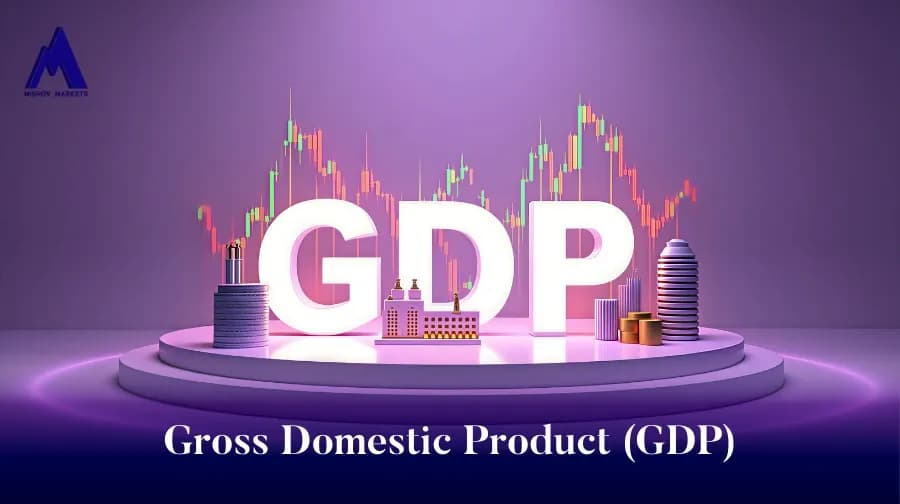Gross Domestic Product (GDP)

Gross domestic product (GDP) is one of the most important indicators of the economy. And in Econville, they felt the lack of its presence for evaluating the health of their economy, just like a trader that needs to know the effect of GDP in forex.
Once upon a time, in a bustling town called Econville, the townspeople were curious about how well their economy was doing. There lived a wise economist named Dr. MISHOV. The decision was made to assess the aggregate value of all the goods and services produced in their town over the course of one year. Dr. Mishov had a special task: to measure the town’s economic health using a magical formula called GDP (Gross Domestic Product).
In Econville, there were four main contributors to GDP:
1. Personal Consumption: Dr. Mishov observed that the townspeople spent money on everyday items like food, clothing, and entertainment. We referred to this spending as Personal Consumption Expenditures, which constituted a significant portion of the GDP.
2. Business Investments: Local businesses invested in new machinery, buildings, and technology to improve their operations. Dr. Mishov paid a visit to a construction site where new homes and office buildings were under construction. The money spent on these projects was known as gross private investment. It included business investments in the items described earlier, as well as people buying new homes. These investments added to the GDP.
3. Government Spending: The town's government spent money on public services like schools, roads, and healthcare. So Dr. Mishov paid a visit to the town hall, where he saw government workers planning new roads and schools. The money the government spent on these projects was called Government Purchases. It accounted for all spending on goods and services by the federal, state, and local governments. This spending also contributed to the GDP.
4. Net Exports: Finally, Dr. Mishov reached the port, where he saw ships loaded with goods leaving for other towns and countries. These were Exports (X). He also noticed ships arriving with goods from other places, which were Imports (M). To calculate the town's net exports, he subtracted the value of imports from exports, resulting in Net Exports (X-M), aka Trade Balances, which was also included in the GDP calculation.
With all this information, Dr. Mishov returned to his study and combined the data using the magical GDP formula:
![]()
This formula helped him understand the total market value of all goods and services produced in Econoville in a given year. By comparing this value with previous years, Dr. Mishov could tell if the town’s economy was growing or shrinking.
One year, Econville faced a challenge. A neighboring town, Tradeville, experienced a shortage of raw materials, which affected Econville's imports. As a result, the cost of goods in Econville rose, and the town's businesses had to adjust their prices. The town's residents kept spending in spite of this, and the government also raised expenditures to boost the economy.
At the end of the year, the townspeople gathered to calculate their GDP with the help of Dr. Mishov. He added up all the personal consumption, business investments, government spending, and net exports. The final number showed that Econville's economy had grown, even though they faced some challenges.
The townspeople realized that GDP was a useful tool to understand the overall health of their economy. It helped them see how much they were producing and consuming, and so, thanks to Dr. Mishov’s efforts, the people of Econoville could make informed decisions about their businesses, investments, and policies, ensuring their town continued to thrive and prosper.
Personal Consumption Expenditure
The PCE price index is known for capturing inflation (or deflation) across a wide range of consumer expenses and for reflecting changes in consumer behavior. For example, if beef prices rise, shoppers may buy less beef and more chicken.
The core personal consumption expenditures price index, which excludes food and energy, is a variant of the overall index. The core index facilitates the observation of the fundamental inflation trend by omitting two categories—food and energy—where prices fluctuate more significantly and frequently than other prices. The Federal Reserve meticulously observes the core PCE price index during the formulation of monetary policy.
It differs from Core CPI in that it only measures goods and services targeted towards and consumed by individuals. This provides valuable insights into consumer spending behavior, as prices are weighted based on the total expenditure per item.
Gross Private Investment
refers to the total amount of money spent by private businesses, households, and non-profit institutions on capital investments within a country’s borders. This includes expenditures on things like machinery, buildings, and equipment.
Components of Gross Private Investment:
- Business Investments: This includes spending on new factories, machinery, technology, and other capital goods. Businesses invest to increase their production capacity and efficiency.
- Residential Investments: This covers the construction of new homes and residential buildings. It’s a significant part of the housing market and reflects the demand for housing.
- Inventory Investments: This involves changes in the stock of unsold goods and raw materials. When businesses produce more than they sell, inventories increase, which is counted as investment.
Government Spending
The value of government-provided free services, whether to individuals (such as education in public elementary schools) or to society as a whole (such as national defense or law enforcement), is factored into government consumption expenditures. In effect, the government is considered the final purchaser of these services. For government-provided services at a reduced cost (such as tuition at public universities), fees paid by the public are recorded as personal consumption expenditures (PCE) if paid by individuals or as intermediate inputs when paid by businesses. To avoid double counting in GDP calculations, government gross investment is defined as the additions to and replacements of government-owned fixed assets. It consists of investment by both the general government and government enterprises in structures (such as highways and schools), equipment (such as military hardware), and intellectual property products (software and R&D), as well as government-owned investment.
Trade Balances
A nation's imports and exports are subtracted by the trade balance formula. For example, imagine a country's exports in the past month were $100 million while its imports were $145 million. The difference between the country's exports and imports is -$45 million (a negative integer).
- Trade Surplus: When the value of exports exceeds the value of imports. This indicates that a country is selling more to the world than it is buying.
- Trade deficit: It occurs when the value of imports exceeds the value of exports. This indicates that a country is buying more from the world than it is selling.
Importance:
- Economic Indicator: The trade balance is a significant indicator of a country’s economic health. A trade surplus can suggest a strong economy, while a trade deficit might indicate economic challenges.
- Currency Value: A trade surplus can lead to a stronger currency, as foreign buyers need to purchase the country’s currency to pay for its goods and services. Conversely, a trade deficit can weaken a currency.
- Policy Decisions: Governments and policymakers use the trade balance to make decisions about trade policies, tariffs, and international agreements.








